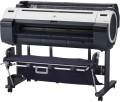Media width (max)
The largest width of paper or other media that the plotter can handle. The larger this parameter, the larger the materials that can be printed on the device; however, the dimensions, weight and cost of the plotter also increase markedly due to this.
Paper grammage (min)
The lowest grammage of paper that the plotter can print normally on. Grammage is expressed in grams per square metre; accordingly, the more dense the paper, the thicker it is, and the greater the difference between the minimum and maximum paper grammage, the greater the range of materials the plotter can operate with.
The use of materials that are too thin can lead to a number of troubles: multi-sheet picking, creasing, jamming, etc. Therefore, if you plan to use low-grammage paper, you should pay special attention to this characteristic.
Paper grammage (max)
The highest paper grammage that the plotter can handle normally. For details about grammage, see "Paper grammage (Min)"; and you should pay attention to its maximum value if you plan to use thick materials. Do not try to print on more dense media than it is specified in the specs of the device: even if the plotter can handle such paper normally, it can cause serious damage.
Number of cartridges
The number of individual cartridges the plotter needs to operate.
Each cartridge is responsible for its base colour used in printing. Monochrome plotters (see "Output Type"), by definition, use only one cartridge, for black colour and for such devices this parameter is usually not specified at all. But in colour printing, where all available shades are obtained by mixing basic colours, the number of such colours (and, accordingly, cartridges) can be different.
The most modest of modern colour plotters are designed to work with
4 or 5 cartridges. The first option corresponds to the CMYK colour scheme with 4 basic colours — this is the minimum required for full colour printing. In turn, 5 cartridges usually mean a CMYK colour scheme, supplemented by a separate supply of black ink for monochrome images — this allows you not to waste consumables for such images that may be needed for colour prints, and also to print monochrome even with empty colour cartridges, and vice versa.
In general, these sets of basic colours are inexpensive, while they are able to provide fairly good quality prints; so plotters for 4 – 5 cartridges are very popular nowadays. However, the use of additional basic colours can significantly increase the quality of the image, primarily the reliability of colour reproduction. Thereby, advanced plotters can provide a larger number of cartridges —
6 – 10, and s
...ometimes more. Such devices are quite expensive and difficult to maintain, but they are indispensable for printing materials with high requirements of colour quality.Cartridge model
Models of cartridges used in the plotter. With this info, you can easily find original consumables for the device.
Storage capacity
The capacity of
the built-in storage installed in the plotter.
First of all, we note that this drive should not be confused with the built-in memory (see above): in this case, we are talking about a storage designed for long-term storage of large amounts of data. Accordingly, such a storage differs from the mentioned memory in a larger capacity — its volume is already calculated in gigabytes. In addition, the built-in drive is usually a hard drive — this type of storage is better suited for the application described. Such a disk is intended mainly for storing various graphic files — footage, layouts for printing, data from a scanner (if available — see above), etc. The larger its volume, the more files can be simultaneously stored in the plotter's memory.
It is often more convenient to upload files into the device's memory in advance and send them to print directly from the control panel than to turn on the master PC every time — especially if you have to print often and a lot, and PCs are sometimes unavailable (for example, due to mismatched work schedules from printers and designers). On the other hand, such functionality is relevant mainly for powerful performant plotters, and the availability of a built-in drive significantly affects the cost. Therefore, this feature is found mainly in fairly advanced models.
Noise level
The maximum noise level produced by the plotter during operation. The lower this indicator, the less inconvenience to others the device will create. At the same time, in modern plotters, the noise level usually does not exceed 60 dB, which is comparable to a TV set at an average volume; and many of them do not "reach" even up to 50 dB, corresponding to a quiet conversation at a distance of 2-3 m. And if we also take into account the fact that plotters are usually used in industrial premises, then we can say that in most cases this indicator does not play a significant role.
Dimensions with stand (WxDxH)
The overall dimensions of the floor plotter (see “Placement”), including the stand, in other words, the dimensions of the device in the operative condition (in addition to the stand itself, other equipment, such as trays for printed materials, is taken into account here). This indicator is worth evaluating how much space is needed to install such a plotter.
Weight
The total weight of the plotter is usually listed without ink and paper. You should pay attention to this parameter foremost when choosing desktop models (see "Placement"): modern plotters are quite massive, which puts forward corresponding requirements for stands for them.

